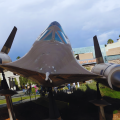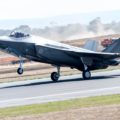
Lockheed F-94 Starfire | |
|---|---|
| Land | Usa |
| Rolle | Allwetter-Abfangjäger |
| Erstflug | 16. April 1949 |
| Gebaut | 855 |
das Lockheed F-94 Starfire was a first-generation jet aircraft of the United States Air Force. It was developed from the twin-seat Lockheed T-33 Shooting Star in the late 1940s as an all-weather, day/night interceptor. The aircraft reached operational service in May 1950 with Air Defense Command, replacing the piston-engined North American F-82 Twin Mustang in the all-weather interceptor role. The F-94 was the first operational USAF fighter equipped with an afterburner and was the first jet-powered all-weather fighter to enter combat during the Korean War in January 1953. It had a relatively brief operational life, being replaced in the mid-1950s by the Northrop F-89 Scorpion and North American F-86D Sabre. The last aircraft left active-duty service in 1958 and Air National Guard service in 1959.
| Lockheed F-94A Starfire Walk Around | |
|---|---|
| Fotograf | Wladimir Nikolajewitsch Jakubow |
| Lokalisierung | Nationalmuseum der USAF |
| Fotos | 56 |
Zugehörige Kits:

| Lockheed F-94C Starfire Walk Around | |
|---|---|
| Fotograf | John Heck |
| Lokalisierung | Unbekannter |
| Fotos | 29 |
Finden Sie Kits bei eBay:
Die Lockheed F-94 Starfire war ein düsengetriebener Abfangjäger, der von 1950 bis 1958 in der United States Air Force eingesetzt wurde. Es wurde entwickelt, um bei jedem Wetter Tag und Nacht gegen feindliche Bomber, insbesondere die sowjetische Tupolew Tu-4, zu verteidigen. Die F-94 basierte auf dem Lockheed T-33 Shooting Star Trainer, hatte aber eine längere Nase, um ein Radar und ein Feuerleitsystem unterzubringen. Es war auch mit einem Nachbrenner ausgestattet, der ihm einen Geschwindigkeitsschub verlieh und es zum ersten einsatzfähigen USAF-Jäger mit dieser Funktion machte. Die F-94 hatte zwei Besatzungsmitglieder: einen Piloten und einen Radar-Operator. Die Hauptbewaffnung der F-94 bestand aus vier 0,50-Zoll-Maschinengewehren in der Nase, und spätere Versionen trugen auch Luft-Luft-Raketen. Die F-94 wurde in verschiedenen Einheiten des Air Defense Command und der Air National Guard eingesetzt und wurde während des Koreakrieges eingesetzt, wo sie mehrere Siege über feindliche Flugzeuge errang. Die F-94 wurde schließlich durch modernere Abfangjäger wie die Northrop F-89 Scorpion und die North American F-86D Sabre ersetzt.
Views : 2587









